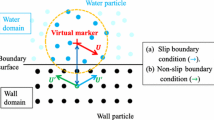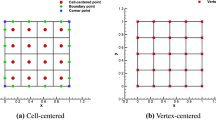Abstract
The implementation of the inlet and outlet boundaries is a key issue in the particle method. The boundary implementation at the inlet applicable to the original MPS method is difficult to be applied to the LSMPS method with higher accuracy. Advanced inlet and outlet boundary implementations are proposed in this study, including inlet boundaries with velocity profile, static pressure, total pressure, and deleted particle detection method for outlet boundary. Three pipe flow cases are used to verify the accuracy of inlet boundaries. For the velocity inlet boundary, the calculation of velocity near the central axis of the pipe has an average error of 0.17%. For the static pressure inlet boundary, the average error of pressure calculation near the central axis is 1.80%. For the total pressure inlet boundary, the numerical final velocity of water in the pipe has a 3.02% error compared with the theoretical result. A reservoir with two inlets and one outlet is used to verify the applicability of the above implementation in a 3D engineering case with five different inlet velocities. The results show that for different velocity inlets, the simulations obtain different filling times, and for velocity and pressure distributions near the outlet in accordance with the theoretical situation. The implementation proposed in this study can be used for practical engineering problems.





















Similar content being viewed by others
References
Gingold RA, Monaghan JJ (1977) Smoothed particle hydrodynamics-theory and application to non-spherical to non-spherical stars. Mon Not R Astron Soc 181:375–389
Lucy LB (1977) A numerical approach to the testing of the fission hypothesis. Astron J 82:1013–1024
Shao JR, Hq Li, Liu GR, Liu MB (2012) An improved SPH method for modeling liquid sloshing dynamics. Comput Struct 100–101:18–26
Hirschler M, Oger G, Niken U, Le Tozue D (2012) Modeling of droplet collisions using smoothed hydrodynamics. Int J Multiph Flow 95:175–187
Chen Z, Zong Z, Liu MB, Zou L, Li HT, Shu C (2015) An SPH model for multiphase flows with complex interfaces and large density differences. J Comput Phys 283:169–188
Zhang A, Sun P, Ming F (2015) An SPH modeling of bubble rising and coalescing in three dimensions. Comput Methods Appl Mech Eng 294:189–209
Zhang C, Rezavand M, Hu X (2021) A multi-resolution SPH method for fluid-structure interactions. J Comput Phys 429:110028
Zhang C, Rezavand M, Zhu Y (2021) SPHinXsys: an opensource multi-physics and multi-resolution library based on smoothed particle hydrodynamics. Comput Phys Commun 267:108066
Koshizuka S, Oka Y (1996) Moving-particle semi-implicit method for fragmentation of incompressible fluid. Nucl Sci Eng 123(3):421–434
Shibata K, Masaie I, Kondo M, Murotani K, Koshizuka S (2015) Improved pressure calculation for the moving particle semi-implicit method. Comput Part Mech 2:91–108
Shibata K, Koshizuka S, Matsunaga T, Masaie I (2017) The overlapping particle technique for multi-resolution simulation of particle methods. Comput Methods Appl Mech Eng 325:434–462
Duan G, Chen B, Zhang X, Wang Y (2017) A multiphase MPS solver for modeling multi-fluid interaction with free surface and its application in oil spill. Comput Methods Appl Mech Eng 320:133–161
Liu X, Zhang S (2021) Development of adaptive multi-resolution MPS method for multiphase flow simulation. Comput Methods Appl Mech Eng 387:114–184
Lv J, Liu X, Wang K, Cheng S, Tong L (2022) Numerical study of gas-injection induced pool sloshing behavior using MPS method. Int J Adv Nucl React Des Technol 4–3:147–155
Tamai T, Koshizuka S (2014) Least squares moving particles semi-implicit methods: an arbitrary high order accurate meshfree Lagrangian approach for incompressible flow with free surfaces. Comput Part Mech 1(3):277–305
Koshizuka S, Shibata K, Kondo M, Matsunaga T (2018) Moving particle semi-implicit method. Academic Press. 155–215, ISBN 9780128127797
Hu F, Wang Z, Tamai T, Koshizuka S (2020) Consistent inlet and outlet boundary conditions for particle methods. Int J Numer Methods Fluids 92:1–19
Duan G, Chen B, Koshizuka S, Xiang H (2017) Stable multiphase moving particle semi-implicit method for incompressible interfacial flow. Comput Methods Appl Mech Eng 318:636–666
Hori C, Gotoh H, Ikari H et al (2011) GPU-acceleration for moving particle semi-implicit method. Comput Fluids 51(1):174–183
Zhang S, Gou W, Wang Y et al (2022) Direct numerical simulation of atomization by jet impact using moving particle semi-implicit method with GPU acceleration. Comput Part Mech 9:499–512
Gou W, Zhang S, Zheng Y (2019) Implementation of the moving particle semi-implicit method for free-surface flows on GPU clusters. Comput Phys Commun 244(13–24):0010–4655
Duan G, Matsunaga T, Yamaji A, Koshizuka S, Sakai M (2021) Imposing accurate wall boundary conditions in corrective-matrix-based moving particle semi-implicit method for free surface flow. Int J Number Methods Fluids 93:148–175
Shibata K, Masaie I, Kondo M et al (2015) Improved pressure calculation for the moving particle semi-implicit method. Comput Part Mech 2(1):91–108
Khayyer A, Gotoh H, Shimizu Y (2017) Comparative study on accuracy and conservation properties of two particle regularization schemes and proposal of an optimized particle shifting scheme in ISPH context. J Comput Phys 332:236–256
Author information
Authors and Affiliations
Corresponding author
Ethics declarations
Conflict of interest
The authors declare that they have no conflict of interest.
Additional information
Publisher's Note
Springer Nature remains neutral with regard to jurisdictional claims in published maps and institutional affiliations.
Rights and permissions
Springer Nature or its licensor (e.g. a society or other partner) holds exclusive rights to this article under a publishing agreement with the author(s) or other rightsholder(s); author self-archiving of the accepted manuscript version of this article is solely governed by the terms of such publishing agreement and applicable law.
About this article
Cite this article
Kong, Y., Zhang, S., Zhang, J. et al. Inflow and outflow numerical simulation using least-square moving particle semi-implicit method on GPU. Comp. Part. Mech. 11, 627–641 (2024). https://doi.org/10.1007/s40571-023-00643-5
Received:
Revised:
Accepted:
Published:
Issue Date:
DOI: https://doi.org/10.1007/s40571-023-00643-5




